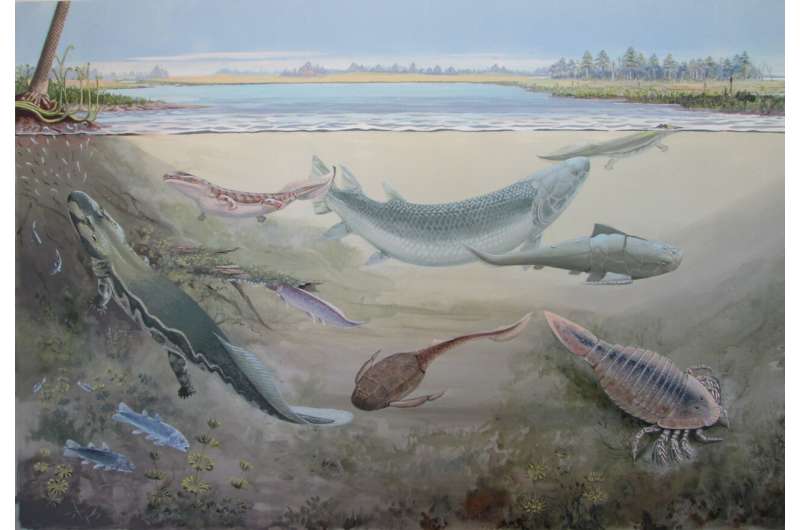Life reconstruction of the non-marine component of the Waterloo Farm biota. Hyneria udlezinye is shown together with the tetrapods Umzantsia amazana and Tutusius umlambo, the placoderms Groenlandaspis riniensis and Bothriolepis africana, the coelacanth Serenichthys kowiensis, the lungfish Isityumzi mlomomde, and a cyrtoctenid eurypterid. Painting by Maggie Newman, copyright R. W. Gess. Credit: Gess, Ahlberg, 2023, PLOS ONE, CC-BY 4.0 (creativecommons.org/licenses/by/4.0/)
A pair of paleontologists, one with Rhodes University's Albany Museum and Geology Department, the other with Uppsala University, has identified a new species of tristichopterid, which is an ancient bony fish. Robert Gess and Per Ahlberg have analyzed the fossil specimen found in South Africa and published their research in PLOS ONE.
Tristichopterid were a type of large bony fish that lived during the Late Devonian Period. For many years, researchers thought that they existed mostly in what is now Australia, but fossils have since been found in parts of Africa and South America. Such findings suggest the fish lived all across the southern part of the ancient supercontinent Gondwana.
Researchers working in South Africa found fossilized scales in 1995 at a dig site called Waterloo Farms, but found it difficult to identify the species. More recently, road builders outside of Grahamstown discovered fossilized remains of an ancient fish and alerted the researchers. After digging it up and studying it in their lab, Gess and Ahlberg identified the remains as a previously unknown species of tristichopterid, calling it Hyneria udlezinye.
With available fossilized remains, dermal bones, fins and skeletal parts and the previously found scales, the researchers were able to reconstruct nearly the entire fish. They found the ancient fish to be approximately 2.7 meters long, making it the largest known bony fish from the Devonian, and estimate the fish lived approximately 350 million years ago.
The fish also had rear fins, suggesting it was a predator that lunged at prey. It had two main kinds of teeth, rows of small ones for chewing and pairs of large fangs for capturing and killing prey. They suggest that it would have resembled a modern fish called the alligator gar, but with a shorter, stubbier snout. Gess and Ahlberg suggest that H. udlezinye likely fed on four-legged creatures that stepped into ancient rivers, known as tetrapods, which are believed to be ancient human ancestors.
Tristichopterid, along with many other species, went extinct at the end of the Devonian Period, approximately 359 million years ago; thus, they have left behind no descendants.
More information: Robert W. Gess et al, A high latitude Gondwanan species of the Late Devonian tristichopterid Hyneria (Osteichthyes: Sarcopterygii), PLOS ONE (2023). DOI: 10.1371/journal.pone.0281333
Journal information: PLoS ONE
© 2023 Science X Network
























